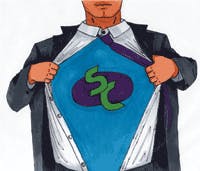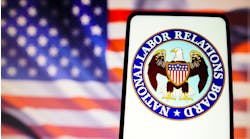When you think of superheroes, a supply chain professional is not the first person who comes to mind. Yet the men and women who oversee logistics, control the supply chain, and manage vendors and suppliers are ideally suited to helping save the world. These people have the ability to initiate process improvements that will enable their companies to commit resources to Corporate Social Responsibility (CSR), a powerful force for good—both for the world and for business.
What is CSR and Why Should I Care?
Many leading organizations use their corporate resources to support community and non-profit causes. The importance of that support to both employees and customers continues to increase.
It's not just a feel-good trend, but a vital component of strategic planning and a good business tool.
Customers want to know your business is looking at more than profits. According to the 2012 Goodpurpose Study by Edelman Inc., 87% of consumers expect companies to give the interests of society equal weight to those of business. And they will put their money behind that belief.
Seventy-three percent of consumers are willing to switch from one brand to another brand that is about the same in price and quality, if the other brand is associated with a good cause.
Furthermore, 71% are willing to promote a brand associated with a cause they support.
It's not just customers who want businesses to do good things. Employees want a socially responsible workplace. According to a 2010 study by the Kenexa Research Institute, employees who see their company investing in a successful CSR campaign are more than three times more likely to positively rate their pride in the organization, willingness to recommend it as a place to work, and overall satisfaction. Since it is these inside stakeholders who can truly create a company that flourishes, a successful CSR program will pay for itself in terms of increased productivity, retention and a positive corporate culture.
Outperform Competitors
There is proof that a successfully run CSR program translates to your bottom line. The Good Company Index ranks the Fortune 100 companies based on each one's actions with respect to their employees, customers and as a steward of the community and environment. They are each assigned a Good Company grade, from A to F. In the 24 months after the index was created, companies that earned a full letter grade or higher than their industry peers on the index – in other words, those that behaved better – outperformed those competitors by an average of 30 percentage points. A 30% advantage for doing something that makes everyone feel good is a pretty compelling reason to make sure your CSR program is the best it can be.
Taking CSR to the Next Level
The policies and procedures of innovative CSR have to be integral to your business. Staff volunteer days or donations to charity won't help solve the world's most pressing social challenges. This is why supply chain and logistics professionals can be the champions. They know how to think outside the box, and can use change management principles to show the CEOs and CFOs how to integrate CSR into the overarching corporate strategy.
Let's apply Richard Beckhard and David Gleicher's Formula for Change to CSR:
D x V x F > R:
D = Dissatisfaction with how things are now;
V = Vision of what is possible;
F = First concrete steps that can be taken towards the vision; and
R = Resistance to change
Resistance to change in CSR strategy is most affected by dissatisfaction with how things are now. Most corporate leaders are satisfied if the company is making money and stockholders are happy.
It is therefore crucial to show people the impact of their actions in nudging them toward innovative CSR. Those in the supply chain, who understand the importance of resource management, life-cycle assessment and supply chain auditing, can drive the conversation to achieve meaningful change.
Wayne Visser, author of "CSR 2.0: Transforming Corporate Sustainability and Responsibility," lists five steps to start the process of meaningful, innovative CSR:
- Re-assess: What are the environmental footprints of your business? What about the social and ethical impacts? Start by creating sustainability and responsibility performance baselines to assess these. There are excellent resources for this from the Global Reporting Initiative (GRI), Carbon Disclosure Project (CDP) and the International Financial Corporation (IFC). Life cycle impact and full cost accounting are measurements which may uncover opportunities for improvement.
- Re-align: By collaborating with other businesses and non-profit organizations that complement your company's mission, you can effect positive change and increase your social capital. Procter & Gamble's Pampers partnership with Unicef, "1 Pack = 1 Vaccine," has been so successful that the World Health Organization expects neonatal tetanus to be eliminated by 2015. In addition, the campaign has resulted in year-on-year growth for the Pampers brand.
- Re-define: Who is the leader at your company who can challenge and inspire all stakeholders with a vision of innovative CSR and a solid strategic plan to achieve the change? Supply chain professionals are in a unique position to help craft that vision, using the tools they possess from methodologies such as Six Sigma and continuous improvement.
- Re-design: How can you redesign products, processes and services to reduce negative impact? Here's where innovation is the entire answer. Regen Energy used Janine Benyus' concept of biomimcry, applying the systems of a beehive to turn a company's appliances and machines into a network, able to balance loads during periods when electricity is expensive or unreliable. Other companies balance their success in the global economy by creating products that improve life in developing nations, such as Unilever's shampoo that works best with cold water and is sold in small packets to be affordable for the poor.
- Re-structure: How do the rules of the game need to be changed? What transformation needs to take place in how organizations operate? It may mean championing legislation that tackles climate change, or it may mean leading an industry-wide initiative to eliminate the use of environmentally damaging chemicals. This final step is the one that guarantees change will last.
Funding Change
The supply chain is an ideal place to find untapped capital for CSR programs. It may be found by uncovering ways to negotiate better vendor and supplier agreements. By showing you are willing to overturn every last stone, you are providing the collaborative leadership a bold CSR strategy needs.
Gina Manis-Anderson, owner of Savii Group, helps companies find ways to free up capital to fund CSR programs.




